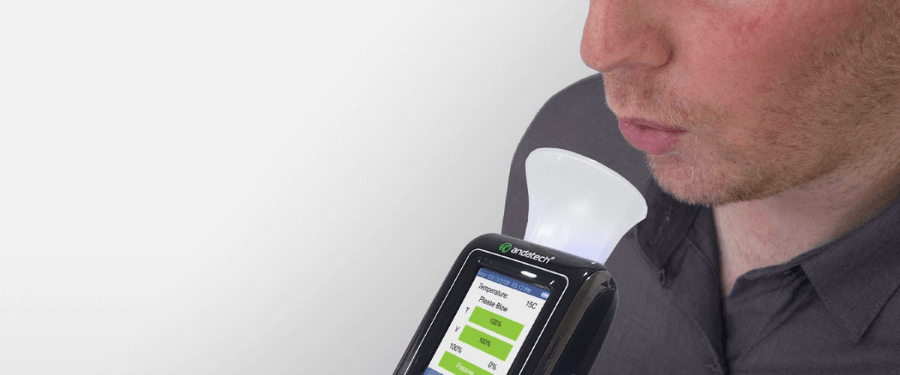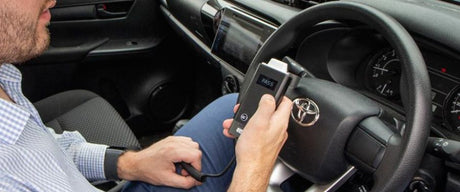Reliable breathalysers are indispensable to the execution of a company’s alcohol and drug testing policy. A breathalyser’s ability to capture accurate breath alcohol test results may be attributed to its delicate sensors, which require proper usage and care not only to help maintain its accuracy, but also to prolong their lifespans, especially when used for high volume breath alcohol testing in the workplace. Here are 10 tips for caring for and maintaining your breathalysers.
1. Wait for at least 20 minutes after drinking, eating, and smoking before using a breathalyser.
Breathalysers are designed to measure the alcohol concentration of deep lung air. The presence of residue, either in the form of food, drink, cigarette smoke, or even mouthwash, in the mouth may interfere with the breath alcohol test result, as residue particles can be exhaled together with deep lung air into the breathalyser. Unlike alcohol which evaporates quickly, this residue might accumulate on the breathalyser sensor over time, causing measurement inaccuracies.
To make sure that only the breath alcohol concentration in deep lung air is measured, it is best for individuals to wait for at least 20 minutes after drinking, eating, and smoking before carrying out a breath alcohol test.
2. Make sure no alcohol-based chemicals are used.
Aside from having alcohol residue in the mouth, alcohol compounds in the air where a breath alcohol test is conducted can impact breath alcohol readings as well. Alcohol content can sometimes be found in cleaning solutions, perfumes, and disinfectants. Exposure to these compounds for a long period of time can gradually affect the accuracy of a breathalyser’s sensor.
When conducting a breath alcohol test, it should be done in an environment where no alcohol-based chemicals have been used recently.
3. Blow with care.
It takes a few seconds of steady and slow blowing into the mouthpiece for a breathalyser’s sensor to detect and measure breath alcohol concentration in exhaled air. This technique prevents spit or excessive moisture from being blown into the breathalyse, which could potentially clog or damage the breathalyser. This applies to both passive testings using a sampling cup and specific testings using a mouthpiece.
Individuals should exercise extra care to blow steadily through the mouthpiece or at the sampling cup to prevent spit from entering the breathalyser.
4. Use new mouthpieces.
Reusing or sharing mouthpieces can cause inaccurate readings due to remaining alcohol residue on the surface of the mouthpiece from previous breath alcohol tests. Even though the alcohol residue concentration may be low, a sensitive breathalyser that can detect breath alcohol concentration down to 3 decimal places might still be able to detect the presence of alcohol.
To prevent a dispute in the breath alcohol results, a new mouthpiece should always be used for the breath alcohol test of each individual.
5. Handle the breathalysers with care.
Similar to other electronic devices, dropping the breathalyser can cause damage to the electronic components and sensor within. Measures should be taken to prevent unnecessary damage to the breathalyser from accidental dropping and shock.
Unlike wall mounted breathalysers, portable breathalysers are not securely installed on a wall or on a stand, placing them at a greater risk for shock and damage. Extra precaution should be taken when handling these breathalysers and they should be kept in their carry case when being transported.
6. Only use alkaline batteries or lithium rechargeable batteries.
Alkaline batteries last longer and have a better discharge curve compared to their non-alkaline counterparts, owing in part to their stable voltage which only drops off towards the end of the battery’s life. On the other hand, non-alkaline heavy-duty batteries have a gradually decreasing discharge rate with time which can impact the accuracy of breathalysers because these batteries require a stable voltage for a breathalyser to function properly. With rechargeable batteries, opt for lithium batteries in place of nickel-metal hydride batteries as these batteries are more durable and stable for use in breathalysers.
It is recommended to use alkaline or lithium batteries for breathalysers to work optimally. It’s worth noting that some batteries are not compatible with certain breathalyser models. Choose the batteries based on manufacturers’ recommendations for best results.
7. Remove batteries when not in use.
Fresh batteries slowly deplete even when left unused in an electronic device for some time. As liquid electrolytes in the batteries break down, the built-up gas can rupture the batteries’ outer casing, causing leakage of corrosive electrolytes in the form of white goo. This can corrode and damage the breathalyser’s circuit.
It is easy to forget about the batteries when a breathalyser is left unused for weeks. Hence, it’s a good practice to remove the batteries before storing your breathalysers.
8. Store the breathalysers in a favourable environment.
Breathalysers are not water-proof and their sensors can be affected by external, environmental factors even when not in use. Excessive moisture and heat are damaging not only to the breathalyser sensor, but also to its batteries.
To minimise damage caused by external sources, breathalysers should be stored in a cool, dry place in their carry case, away from direct sunlight to prolong their lifespans.
9. Use the breathalysers regularly.
The fuel cell sensor of a breathalyser is a porous disk soaked with an acidic solution containing electrolytes that play an important role in measuring breath alcohol concentration. This solution can dry out when the breathalyser has not been used over time, causing inaccurate readings. When the breathalyser is used regularly, some moisture is introduced into the sensor through exhaled breath blown into the breathalyser, which maintains the quality of the acidic solution in the sensor.
For maintenance purposes, breathalysers should be used at least once a week even when breath alcohol testing is not being actively conducted in the workplace.
10. Send the breathalysers for periodic calibration.
It is normal for breathalysers to experience sensor drift which causes them to become less accurate due to various factors. To best determine a breathalyser’s accuracy, a calibration should be conducted by a professional technician. The technician will test the breathalyser using simulated exhaled air with a known concentration of alcohol and ‘reset’ the breathalyser’s accuracy. If the breathalyser does not function properly, immediate action can be taken to rectify the issue.
Breathalysers should be sent for calibration once every 6 to 12 months, based on the manufacturers’ recommendation. The more frequently the breathalyser is used, the more frequently it should be calibrated to maintain its performance and accuracy.
Paying attention to these details goes a long way. Even though an Australian Standard AS3547 certification endorses the reliability and accuracy of a breathalyser, using, storing, and maintaining the breathalyser according to best practices is, ultimately, key to ensuring optimal breathalyser performance. Structured training programs should be made available to employees to solidify their understanding of proper breathalyser usage and maintenance. It takes a team to cultivate good practices, so getting your employees involved and keeping them informed in the early stages is crucial.





